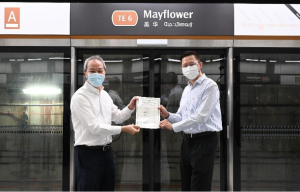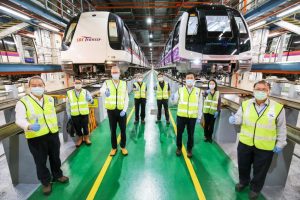 Singapore’s Land Transport Authority (LTA) handed over six stations of Thomson-East Coast Line Stage 2 (TEL2) to the rail operator SMRT with services expected to be launched third quarter of this year.
Singapore’s Land Transport Authority (LTA) handed over six stations of Thomson-East Coast Line Stage 2 (TEL2) to the rail operator SMRT with services expected to be launched third quarter of this year.
Ong Ye Kung, the Minister for Transport, Ng Lang, the CEO of LTA, Neo Kian Hong, the CEO of SMRT Group and Henri Poupart-Lafarge, the CEO of Alstom attended the ceremony.
Alstom is the supplier of the trains under a contract signed in 2018 for six additional Metropolis trains (36 metro cars) and 11 additional Metropolis trains (33 metro cars) for the extensions of North East Line (NEL) and Circle Line (CCL) respectively. Besides rolling stock, Alstom also supplied Urbalis signalling system to North East Line and Thomson-East Coast Line.
The civil and structural works for the stations along TEL2 have been completed, with some architectural, electrical, and mechanical works ongoing. The Land Transport Authority has also completed rigorous testing and commissioning of the trains and systems for TEL2, including tests to ensure that the new stations operate seamlessly with the three TEL1 stations – Woodlands North, Woodlands and Woodlands South.
 Following the handover, SMRT will conduct its tests to validate the operational readiness of TEL2 systems and familiarise its staff with TEL2 operations. Emergency preparedness exercises will also be carried out during this period.
Following the handover, SMRT will conduct its tests to validate the operational readiness of TEL2 systems and familiarise its staff with TEL2 operations. Emergency preparedness exercises will also be carried out during this period.
The second section of TEL comprises the six stations of which one interchange station (Caldecott station) that connects to the Circle Line (CCL).
With TEL2 in service, residents from the 100,000 or so households within a 10-minute walk from one of the nine stations along TEL1 and TEL2 can expect time savings of up to 50 per cent when travelling via these stations.
The 43 km Thomson-East Coast Line is Singapore’s sixth MRT line, adding 32 new stations to the existing rail network, with eight interchange stations in total. The line will be opened in five stages. The first section was put into commercial service on January 31, 2020 and the remaining sections are expected to enter operation by 2024.
Share on:



